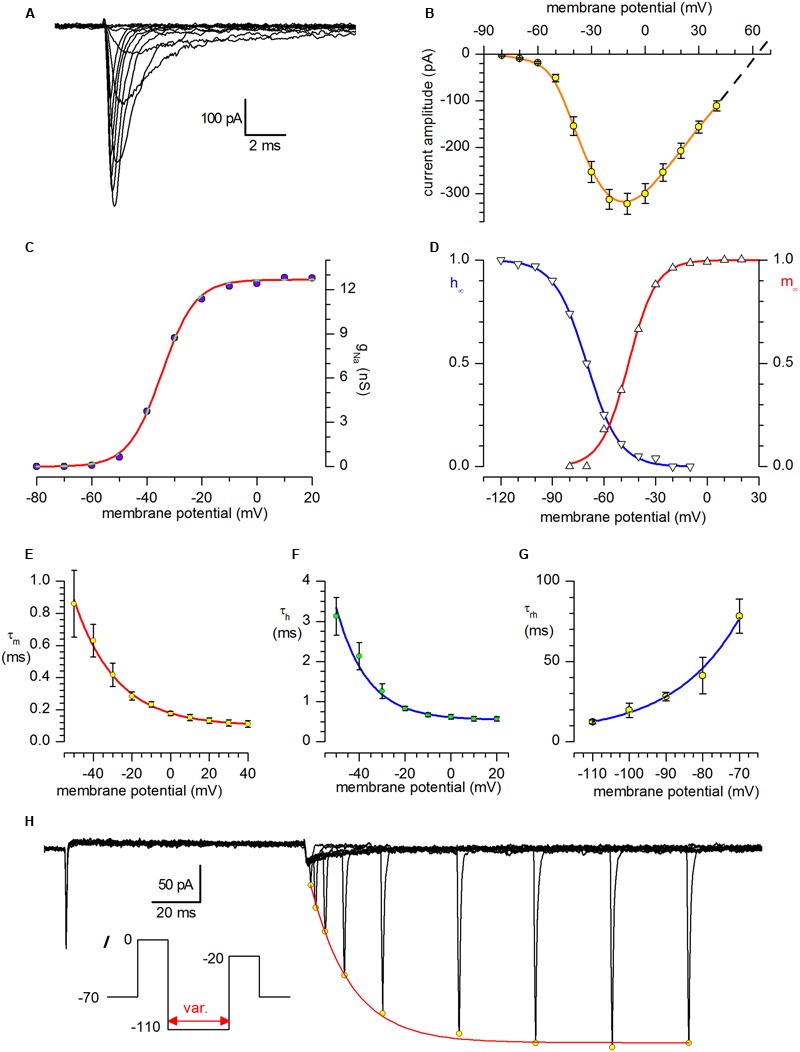FIGURE 3.

Sodium current. (A) Family of sodium currents recorded after IK block with and suppression of spontaneous synaptic currents with kynurenate (1 mM) and bicuculline (10 μM). The holding potential was -70 mV, and the depolarising pulses, in 10 mV increments, were preceded by 250 ms preconditioning at -100 mV; internal solution IC2 plus extracellular Cd2+ 100 μM. (B) I–V relationship for INa; mean amplitudes ±SE from 31 different neurones. The dashed line is the linear regression of the last four values extrapolated to the abscissa to calculate the reversal potential; the theoretical ENa is +61.4 mV. (C) Voltage dependence of Na conductance. gNa(V) was calculated from INa(V)/(V - ENa), using INa(V) values given corrected for inactivation obtained by extrapolating the current decay at the zero time, and ENa = +63 mV. The interpolating line is the fit with the Boltzmann equation, gNa(V) = gNa,max/(1 + exp((Vh – V)ze/kT)-1), with Vh = -34.6 mV, z = +4.3, and gNa.max = 12.7 nS. (D) Steady-state activation (m∞) and inactivation (h∞) curves for the Na-channel. The continuous lines, resulting from the analysis of a 31-neuron sample for activation and 23 neurones for inactivation, obeys the Boltzmann equation h∞(V) = 1/[1 + exp((V - V50)/kha)] with midpoints of -45.8 and -70.0 mV and slopes of 8.1 and 9.4 for activation and inactivation, respectively. (E) Activation time constant, τm, at potentials from -110 to -70 mV; the continuous line, a purely phenomenological description of τm vs. voltage, obeys the equation τm = 0.07796 * exp (-V/21.752) + 0.00992. (F) Inactivation time constant, τh, at potentials from -50 to +20 mV; the continuous line is a phenomenological description of τh vs. voltage, and obeys the equation τh = 0.0679 * exp (-V/13.5) + 5.43. (G) Time constant for removal of inactivation, τrh, at potentials from -110 to -70 mV; the continuous line, a purely phenomenological description of τrh vs. voltage, obeys the equation τrh = 3853 * exp(-V/-17.58) + 5.11. (H) INa removal of inactivation. Double-pulse protocols (inset) produced transient outward currents of increasing amplitude following increments of the interpulse width. The peaks of the outward current (open circles) are interpolated with an exponential function. The fitted curve (single exponential) gives a time constant for the removal of inactivation, τha, of 16.8 ms in the cell shown.
